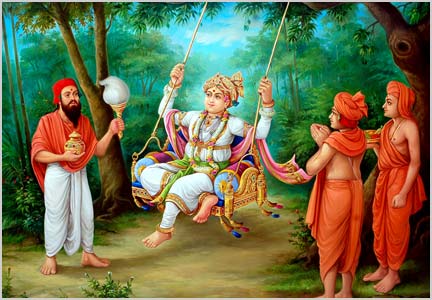 |
| LORD SWAMINARAYAN WRITES SHIKSHAPATR |
Lord
Swaminarayan directed all His disciples- Tyagis and Gruhasthas who
were learned and were writers and poets to devote their time in writing
books and composing Kirtans. He asserted that, good literature is one
which prescribes in details the philosophy and customs of the Sampraday
and which describes the divine life of God Supreme. This kind of
literature promotes the welfare of the members of the Sampraday. But
before giving these directions to the learned members, Lord Swaminarayan
Himself wrote Shikshapatri in Sanskrit on the 5th day of bright half of
Maha of Samvat year 1882, at Vadtal. Shikshapatri, a small
book-contains only 212 verses in Anustup Chhand.
Swaminarayan Sampraday history is to all shashtra of mening and reading very inportant.
Though it is addressed and written for the well-being of the members of the
Sampraday, it is equally very useful and beneficial to others also. It may be definitely said that any one, whether he be a member of the Sampraday or otherwise, who follows sincerely the dictates of
Shikshapatri, without doubt, becomes happy and prosperous in this life and life here-after. It describes in minute details the duties of the followers- Acharyas, Tyagis, Gruhasthas and females. But non-members can also follow them with ease and advantage.
Shikshapatri means Hit-tam Updesh. The word Hit-tam means ultimate real
well-being in life here and in life here-after. It is a gross mistake to
treat Shikshapalri as merely a book of Does and Don'ts for the
followers of the Sampraday. Satangis even today treat Shikshapatri as
direct orders from the divine mouth of Lord Swaminarayan
First ten verses are introductory; then seventy verses explain duties common to all; then ten verses give the names of other Shastras which have been accepted as dearer to Lord Swaminarayan. Then fifteen verses explain philosophic terms and unique monotheism propounded In the Sampraday. The rest then describes special duties or Acharyas, Gruhasthas, Females and Tyagis i.e. Sadhus, Brahmcharies and Parshads. The last ten verses describe Falashruti or SHIKSHAPATRI.
There are only three works in the Sampraday written by Lord Swaminarayan Himself. First is the summary of six Shastras- namely Bhagvat, Bhagvad-Gita, VidoorNeeti, VishunusahastraNaam, VasudevMahatmya, YajnavalkyaSmruti, which was prepared by Him for His daily reading, when He was only ten years old. Second is a letter He wrote to Ramanand Swami on the fifth day or dark half of Falgun of Samvat year 1856 and third is His Shikshapatri.


















